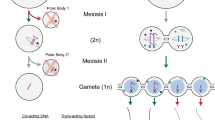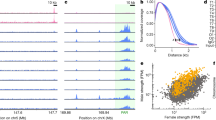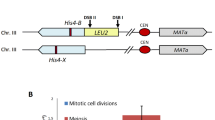Abstract.
Homologous recombination plays a central role during meiosis, ensuring the proper segregation of homologous chromosomes during the first meiotic division. In addition, meiotic recombination generates genetic variability upon which natural selection can act. The frequency of recombination is not evenly distributed throughout the genome: regions of high (hotspots) and low (coldspots) recombination can be found. Meiotic hotspots exhibit high levels of double-strand break formation and these breaks coincide with the upstream regions of genes. In many cases, binding of transcription factors has been shown to be required for hotspot activity. We review the current knowledge on the mechanisms that determine hotspot activity and propose a modified model to account for recent observations which show that recombination frequency at hotspots is sensitive to environmental conditions.
Similar content being viewed by others
Author information
Authors and Affiliations
Additional information
Electronic Publication
Rights and permissions
About this article
Cite this article
Koren, A., Ben-Aroya, S. & Kupiec, M. Control of meiotic recombination initiation: a role for the environment?. Curr Genet 42, 129–139 (2002). https://doi.org/10.1007/s00294-002-0340-9
Received:
Revised:
Accepted:
Issue Date:
DOI: https://doi.org/10.1007/s00294-002-0340-9




